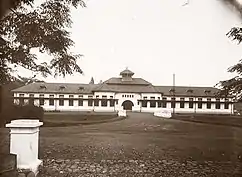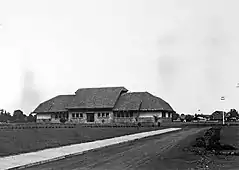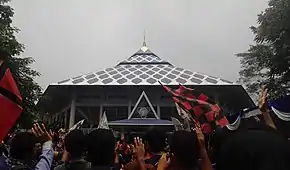IPB University
IPB University[2][3] (Indonesian: Institut Pertanian Bogor, abbreviated as IPB) is a state-run agricultural university based in the regency of Bogor, Indonesia.
Institut Pertanian Bogor | |
_symbol.svg.png.webp) | |
| Motto | Inspiring Innovation with Integrity |
|---|---|
Motto in English | Inspiring Innovation with Integrity in Agriculture, Ocean, Biosciences for a Sustainable World |
| Type | State university |
| Established | September 1, 1963 |
| Rector | Prof. Dr. Arif Satria, S.P., M.Si. |
| Location | , |
| Campus | Both urban and rural total 6,651,635 m² |
| Affiliations | ASAIHL[1] |
| Website | www.ipb.ac.id |
The institute began as an agricultural school formed by the Dutch colonial regime in the early 20th century. After independence it was part of the University of Indonesia before becoming an independent institute on September 1, 1963.[4][5] Prof. Dr. Arif Satria, S.P., M.Si. serves as its director.[6]

History

The first school in Bogor was established in 1876 under Rudolph Scheffer, under the name landbouwschool te Buitenzorg (agriculture school).[7] New schools for different fields were opened in the following years for Native Indonesians. The institute started in the early 20th century as a veterinary medicine and agricultural school.[4] Before World War II, the institutions were known as Middelbare Landbouwschool (secondary agricultural school), Middelbare Bosbouwschool (secondary forestry school) dan Nederlandsch Indiche Veeartsenschool (veterinary school).[4] H. J. Lovink's appointment as department director of agricultural education in 1910 marked a curriculum shift toward training for the government and private sides of colonial agribusiness, including basic biology classes augmented with practical education about cultivation techniques and technologies.[8] Lovink argued that department officials in the Ministry of Agriculture "needed to familiarize themselves with Javanese farming practices."[8]

In 1940, the Dutch government founded an Institution of Agricultural Higher Education in Bogor with the name Landbouw Hogeschool, which later on 31 October 1941 was called Landbouwkundige Faculteit (Agronomy Faculty). However, the school was closed down during the Japanese occupation (1942-1945). The Nederlandsch Indische Veeartsenschool remained in operation, but its name was changed to Bogōru jūigakkō (ボゴール獣医学校) (Bogor Veterinary School).[4]
Sometime after the declaration of independence in 1946, the Ministry of Social Welfare of the new Republic of Indonesia upgraded the Veterinary School in Bogor to the College of Veterinary Medicine (PTKH).[4]
The Netherlands returned to Indonesia and retook control of the institution in 1947, thus Landbouwkundige Faculteit was reopened as the Faculteit Voor Landbouw-Wetenschappen, which had majors in Agriculture and Forestry. In 1948 the PTKH or College of Veterinary Medicine was changed to Faculteit voor Diergeneeskunde under Universiteit van Indonesië (later the University of Indonesia).[4]
After Indonesia gained its independence in 1950, Landbouw-wetenschappen became the Faculty of Agriculture of the University of Indonesia, with three departments — Socio-Economics, Physical Sciences, and Forestry. In 1957 the Department of Land Fishery was formed. Meanwhile, Faculteit voor Dieergeneeskunde became the Faculty of Veterinary Medicines and Animal Husbandry.[4]
IPB was founded on September 1, 1963 by the decision of the Minister of Science and Higher Education No. 92/1963 and was approved by President Sukarno's decree No. 279/1965.[5] At the time, the two faculties of University of Indonesia which is in Bogor were separated into an independent institution. The new university (IPB) has five faculties: Agriculture, Veterinary Medicine, Fisheries, Animal Science, and Forestry. In 1964 the Faculty of Technology and Mechanization of Agriculture was added.[5]
Symbol and flags
Logo and philosophy
The logo consist of "Institut Pertanian Bogor" text, a tree with three branches and five leaves, and an open book which are all lined by a white circle on a blue background. The logo reflects IPB as an academic institution, source of knowledge and technology, with the "Tridarma Perguruan Tinggi" obligation.
The basic blue color symbolizes IPB as a science and technology university, the open book symbolizes IPB as a source of knowledge, the circle symbolizes that science has no limits and always growing, the three branches growing from the book symbolize Tridarma Perguruan Tinggi (IPB's three commitments: Education, Research, and Community Service), and the five leaves represent the first five faculties of IPB and symbolize Tridarma Perguruan Tinggi which is based on Pancasila.[11]
Flags
The Institut Pertanian Bogor main flag is yellow with IPB emblem in the middle. Each faculty has its own logo and flag based on the IPB logo and flag.[11]
- Diploma Program: black.[11]
- Faculty of Agricultural Engineering and Technology: red.[11]
- Faculty of Agriculture: green.[11]
- Faculty of Animal Science: brown.[11]
- Faculty of Economics and Management: orange.[11]
- Faculty of Fisheries and Marine Science: light blue.[11]
- Faculty of Forestry: grey.[11]
- Faculty of Human Ecology: tosca green.[11]
- Faculty of Mathematics and Natural Science: white.[11]
- Faculty of Veterinary Medicine: violet.[11]
- School of Business: maroon.[11]
Faculties have a white IPB emblem in the middle, except the Faculty of Mathematics and Natural Science. The Faculty of Mathematics and Natural Science have a blue colored IPB emblem in the middle.[11]
Campuses
Faculties and departments

Institut Pertanian Bogor has agricultural, livestock, veterinary, and life science studies.
IPB consist of nine faculties providing an undergraduate program.[13] Graduate and postgraduate programs are managed by a separate graduate school. In 1972, IPB implemented a four-year undergraduate curriculum and, in 1975, opened the first graduate school in Indonesia.
IPB undergraduate new students are required to pass a Common First Year Program (Tingkat Persiapan Bersama (TPB)) or know well-known as General Competency Education Program (Program Pendidikan Kompetensi Umum (PPKU)) before entering any faculties or department although they are enrolled as a student of specific faculties and department.[14] They are also required to live in dormitories during the first year.
Institut Pertanian Bogor has a diploma program that is separated from the faculties and managed under the Directorate of Diploma Program. Unlike the undergraduate students, a common first year program is unavailable for diploma program students.
Faculty of Agriculture
Faculty of Veterinary Medicine
- Anatomy, Physiology and Pharmacology
- Animal Diseases and Veterinary Public Health
- Clinics, Reproduction and Pathology
Faculty of Fisheries and Marine Science
- Aquaculture
- Resources Management Living Aquatic
- Marine Science and Technology
- Fisheries Resources Utilization
- Aquatic Product Technology
Faculty of Forestry
The Faculty of Forestry in 1963 consisted of two departments: Forest Management and Exploitation; and Forest Products Processing. Which later became the Department of Forest Products in 1969 and then the Department of Forest Products Technology in 1983, when Department of Forest Resources Conservation was formed. In 2005, Faculty of Forestry developed into its present four departments:
- Forest Management
- Forest Product Technology
- Forest Resources Conservation and Ecotourism
- Silviculture
It offers bachelor's and master's degrees and doctorates in forest management science, fiber and composite technology, forest product quality improvement and engineering, tropical biodiversity, ecotourism and environmental services management, and tropical silviculture.
Faculty of Agricultural Engineering and Technology
- Mechanical and Biosystem Engineering (previously Agricultural Engineering[15])
- Food Science and Technology
- Agroindustrial Technology
- Civil and Environmental Engineering
Faculty of Mathematics and Natural Sciences
- Geophysics and Meteorology
- Department of Statistics
- Biology
- The Department of Biology consists of Undergraduate Program in Biology (S1); Master Program (S2) and Doctoral Program (S3) in Microbiology, Animal Biosciences, and Plant Biology. All study programs have been accredited A by Badan Akreditasi Nasional Perguruan Tinggi (BAN-PT). Education, Research, and Community Service activities in the department are supported by well planned programs and good quality of faculty members. Student activities are fully supported by the department.
- Chemistry
- Mathematics
- Computer Science
- Physics
- Biochemistry
Faculty of Economics and Management
History
The Faculty of Human Ecology (FEMA) is the youngest faculty in IPB; it was established on August 2, 2005 by the Rector's decree no. 112/K13/OT/2005. his establishment was IPB's answer to changes that were taking place toward the era of higher education autonomy (IPB BHMN) which granted the university the power to form new study programs, departments, and faculties.
The roots of FEMA IPB were the former Department of Community Nutrition and Family Resource (GMSK) of Faculty of Agriculture; Study Program of Agriculture Extension and Communication of Socioeconomy Department, Faculty of Agriculture; and socioeconomic study programs of all the other faculties in IPB.
The Department of Community Nutrition and Family Resource (GMSK) of Faculty of Agriculture was developed into Department of Community Nutrition (GIZ) and Department of Family and Consumer Sciences (IKK). While the Department of Agricultural Socioeconomy (SOSEK) of Faculty of Agriculture was transformed into Department of Communication and Community Development (KPM), Department of Agribusiness, and Department of Environmental Resource Economy (ESL). Furthermore; through the clustering process; the Department of Community Nutrition (GIZ), the Department of Family and Consumer Sciences (IKK), and the Department of Communication and Community Development (KPM) merged up to become the Faculty of Human Ecology (FEMA).
FEMA IPB is the first and only faculty of its kind in Indonesia and it is one of the three faculties of human ecology throughout South East Asia. The others are in the College of Human Ecology University of Philippines at Los Banos (UPLB) and the Faculty of Human Ecology, Universiti Putra Malaysia (UPM).
- The university conducts higher education on human ecology focusing on nutritional sciences, family and consumer sciences, and communication & community development sciences.
- It runs researches and advances the development of science and technology in human ecology for social transformation.
Departments
Community Nutrition
Mandate:
To develop human nutrition science and its application in individual, family and community that involves agriculture, food, nutrition, and health.
Sections:
Seed Center
The university plans develop a Seed Center at Leuwikopo, Dramaga, Bogor due to Indonesia has to import seeds so far and facing a problem of seed supply. The center will develop agricultural seeds, plantation seeds, animal husbandry and fishery.[16]
Green Campus
Starting on September 1, 2015 no ordinary fuel-vehicles are allowed to enter Green Campus Area. The authority provides 1,500 rental bikes, 44 electric cars and 20 gas-fueled buses. Electric cars and buses should have their fare paid electronically.[17]
Student organizations
- The Student Consultative Assembly (Majelis Permusyawaratan Mahasiswa / MPM): student consultative body only available at university level.
- The Student Representative Council (Dewan Perwakilan Mahasiswa / DPM): student legislative body at university level and faculty level.
- The Student Executive Board (Badan Eksekutif Mahasiswa / BEM): student executive body at university and faculty level.
- The Student Activities Unit (Unit Kegiatan Mahasiswa / UKM): several organizations purposed to aid developing students' hobby, talent, or interest.
- Spirituality: Islamic Students Spiritual Agency (BKIM, Badan Kerohanian Islam Mahasiswa), Fellowship of Christian Students (PMK), Indonesia Catholic Student Union (KEMAKI), Buddhist Student Union (KMBA), and Hindu Dharma Student Union.
- Sports: Soccer, Futsal, Basket Ball, Badminton, Volley Ball, Table Tennis, Tennis, Chess, and Archery.
- Martial Arts: Pencak Silat, Aikido, Karate BKC, Tae Kwon Do, Sin Lam Ba, and Thifan Po Khan.
- Arts: Agria Swara Student Choir, Sundanese Art Environment "Gentra Kaheman", and Musical Art "Music Agriculture X-pression".
- Specialized activities: Student Regiment, Scout, Nature Lovers "Lawalata", PMI Voluntary Corps, and Center of Entrepreneurship Development for Youth (Century).
- Academics: International Association of Students in Agriculture and Related Sciences-Local Committee IPB (IAAS-LC IPB), Fauna Conservation Union (UKF), Scientific Studies Forum (FORCES-IPB).
- Journalistic: Gema Almamater, and Campus Newspaper.
Notable alumni
- Susilo Bambang Yudhoyono, sixth president of Indonesia[18]
- Siti Nurbaya Bakar, Minister of Environment and Forestry (2014–Present)
- Ir. Suswono MM, Minister of Agriculture (2009–2014)
- Anton Apriantono, Minister of Agriculture (2004–2009)
- Taufik Ismail (1935-), writer and poet
- Dr. Ir. Hasjrul Harahap, Minister of Forestry and Plantation (1988–1993)
- Nur Mahmudi Ismail, Minister of Forestry and Plantation (1999–2001), Mayor of Depok (2005–2010)
- Mustafa Abubakar, State Minister for State Enterprises (2009–2011)
- Andi Hakim Nasoetion, scholar
- Sajogjo, founder of Indonesian poverty line
- Bungaran Saragih, Minister of Agriculture (2001–2004)
- Rokhmin Dahuri, Minister of Marine and Fishery (2001–2004)
- Andung A. Nitimihardja, Minister of Industry (2004–2005), Commissioner of PLN
- Iqbal Assegaf, Indonesian political activist
- Prof. Dr. Ir. Sjarifuddin Baharsyah, Minister of Agriculture (1993–1998)
- Prof. Dr. Ir. Yustika Baharsyah, Minister of Agriculture (March 1998-December 1998) and Minister of Social
- Prof. Dr. Ir. Didik J Rachbini, Professor at the University of Indonesia and Member of Parliament (2004–2009)
See also
References
- Association of Southeast Asian Institutions of Higher Learning Official Website Archived July 4, 2015, at the Wayback Machine
- Prasetia, Andhika (2019-01-30). "IPB Kini Rebranding Jadi 'IPB University', Apa Alasannya?". detiknews (in Indonesian). Retrieved 2019-03-09.
- Media, Kompas Cyber (2019-01-30). "Nama Baru Janji Baru, IPB Berganti Nama Menjadi IPB University". KOMPAS.com (in Indonesian). Retrieved 2019-03-09.
- History of IPB Embryonal Step (1941-1963)
- History of IPB Growth phase.
- History of IPB - Rectors retrieved September 1, 2013
- "Scheffer, Rudolph Herman Christiaan Carel". National Herbarium of the Netherlands. Retrieved 29 January 2014.
- Goss, Andrew (2011). The Floracrats: State-Sponsored Science and the Failure of the Enlightenment in Indonesia. United States of America: University of Wisconsin Press. p. 92. ISBN 978-0-299-24864-2 – via Open Edition.
- IPB Undergraduate system.
- IPB Undergraduate system evaluation.
- "Symbol and Flag" (Press release). IPB. 25 September 2013. Retrieved 25 September 2013.
- "Lokasi Kampus IPB" (Press release) (in Indonesian). IPB. 20 April 2010. Retrieved 20 June 2010.
- "Faculties and Departements" (Press release). IPB. 25 September 2010. Retrieved 25 September 2013.
- "Visi dan Misi". Tingkat Persiapan Bersama IPB. Archived from the original on 27 September 2013. Retrieved 25 September 2013.
- Departement of Mechanical and Biosystem Engineering history retrieved on 30 August 2013
- "IPB prepare to launch Seed Center". ANTARA News. Retrieved 25 September 2013.
- M. Sidik Permana (September 1, 2015). "IPB Bans Oil-fueled Vehicles".
- Biography of President Susilo Bambang Yudhoyono Archived 25 December 2007 at the Wayback Machine
| Wikimedia Commons has media related to Bogor Agricultural University. |